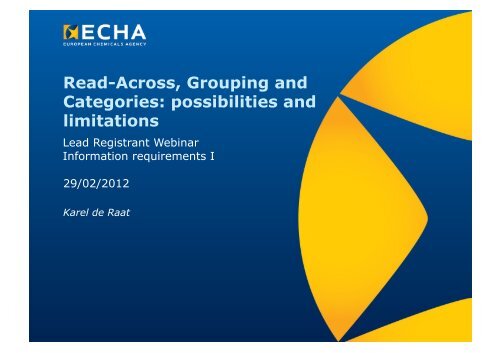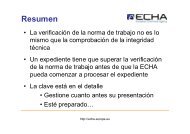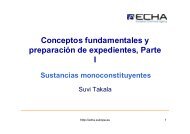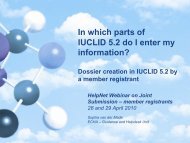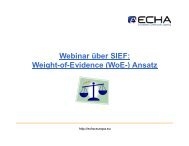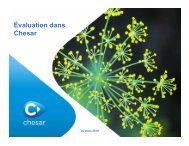Read-Across, Grouping and Categories: possibilities and ... - Europa
Read-Across, Grouping and Categories: possibilities and ... - Europa
Read-Across, Grouping and Categories: possibilities and ... - Europa
You also want an ePaper? Increase the reach of your titles
YUMPU automatically turns print PDFs into web optimized ePapers that Google loves.
Groups <strong>and</strong> <strong>Categories</strong> (4)• <strong>Read</strong>-across is strengthened when the responsesof source chemicals in a group point in the samedirection, while it is obviously weakened if thesource chemicals point to different directions.• Many-to-one read-across is better practicethan one-to-many.• The number of targets that can be covered by onesource depends on the strength of the readacross.29/02/2012 11
Groups <strong>and</strong> <strong>Categories</strong> (5)• <strong>Read</strong>-across from one source to many targets hasthe undesirable effect that it multipliesuncertainty over many hazard assessments.• It is better to test a number of additional sources,so as to come to a better prediction of thehazards.29/02/2012 12
<strong>Read</strong>-across (1)• <strong>Read</strong>-across introduces extra uncertainty!• The data requirement is normally met by means of anexperimental study (for instance an oral 90-day studywith rats).• Extra uncertainty introduced by read-across:translation from an experimental study with a similarsubstance to the experimental study with theregistered substance.• REACH guidance: this uncertainty is to be addressedby means of extra uncertainty factor (AF) during DNELderivation; at least 2.29/02/2012 13
<strong>Read</strong>-across (2)• <strong>Read</strong>-across means that properties are predicted <strong>and</strong>not directly measured.• The registrant has to explain why this is possible;not ECHA.• So the core of every read-across proposal, whetherbased on groups or on categories, should be such anexplanation (a.k.a. read-across hypothesis).• Often, this explanation needs to be supported withexperimental data.• No sufficient explanation, no acceptance!29/02/2012 14
Possible supporting data• Depends obviously on the explanation.• Data on the absorption, distribution, metabolism,excretion <strong>and</strong> elimination of source <strong>and</strong>/or target;toxicokinetics or ADME.• In vitro data that are related to the effect for whichread-across is proposed.• In silico investigations.• Data for other REACH-relevant properties.Any scientific evidence that really enhancesthe credibility of the read-across explanation29/02/2012 15
Registrants should always make their case!29/02/2012 16
Part of the Legal Text:• Adequate <strong>and</strong> reliable documentation of theapplied method shall be provided29/02/2012 17
Structural Similarity = Basis of <strong>Read</strong>-<strong>Across</strong>• The identity of a substance is defined by structures,composition <strong>and</strong> so-called chemical descriptors.The statement “these chemicals are similar” has nomeaning in the context of REACH.29/02/2012 18
Core of every RA explanation• What makes the source <strong>and</strong> target structurally similar<strong>and</strong> how is that related to the endpoint for which adata-gap has to be filled by means of read-across;• What makes the source <strong>and</strong> target structurallydissimilar <strong>and</strong> how does that affect the <strong>possibilities</strong> toread-across29/02/2012 19
Possible <strong>Read</strong>-<strong>Across</strong> “Explanations” (1)• Trend analysis combined with a mechanisticexplanation; e.g., there is also a credible explanation as to why <strong>and</strong> how thecategory-defining property (for instance number of C-atoms)relates to the REACH-relevant property (for instance repeateddose toxicity in rats after 90 days of oral exposure);• Trend analysis only - if the trend in a category isstrong <strong>and</strong> reliable.29/02/2012 20
Possible <strong>Read</strong>-<strong>Across</strong> “Explanations” (2)• Trends in other endpoints than the endpoint forwhich a data-gap has to be filled. For instance, when many other toxicological parameters show aclear common trend, it may be reasoned that the read-acrossendpoint will follow the same trend. This explanation often has tobe combined with other explanations, for instance explanationsbased on mechanistic considerations.• Formation of identical metabolites/ chemicaltransformation products <strong>and</strong> equal exposure ofthe sensitive organs/tissues.• Source <strong>and</strong> target or their metabolites are similarenough to have similar effects <strong>and</strong> kinetics.29/02/2012 21
Worst-case approach• Depending on the role of the outcome of read-acrossin hazard assessment, a worst-case approach can befollowed.• In some cases, it is possible to argue that the sourcewill anyhow be more toxic than the target.• An underestimation of a hazard is then prevented.• Is the overestimation acceptable?• What if the read-across is not conservative enough<strong>and</strong> there is an underestimation of a hazard?29/02/2012 22
Identity of substances• The validity of read-across may be affected by thecomposition of, <strong>and</strong> impurities in the source <strong>and</strong>/ortarget;• In particular, if impurities in the target contribute tothe toxicity while they are not present in the source.29/02/2012 23
Evaluation of <strong>Read</strong>-<strong>Across</strong> Proposals• Depends on the role of the read-across in the REACHregistration dossier; it can be part of a weight of evidence analysis; its purpose can also be to meet an entire information requirement; is it qualitative or quantitative? it can be part of an integrated testing strategy.• Many cases are rejected because essentialinformation is lacking;• Quality of the explanation <strong>and</strong> the supporting dataplay a crucial role in ECHA’s evaluation;• The evaluation is ultimately based on expert judgement;• Uncertainty or lack of quality may be compensated for byextra uncertainty factors <strong>and</strong> thus by lower DNELs.29/02/2012 24
Thank YouKarel de Raatecha.europa.eu/contact


